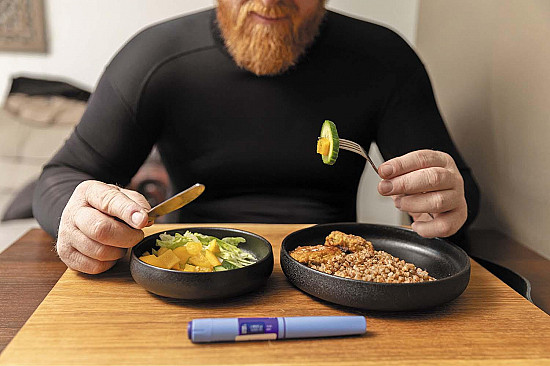GLP-1 diabetes and weight-loss drug side effects: "Ozempic face" and more
- Reviewed by Howard E. LeWine, MD, Chief Medical Editor, Harvard Health Publishing; Editorial Advisory Board Member, Harvard Health Publishing

GLP-1 drugs for diabetes and weight loss have proven to be very effective, but they do have side effects. Among those side effects is "Ozempic face," where skin on the face sags and wrinkles. "Ozempic face" was coined in reference one of these drugs, although any rapid weight loss can cause it.
What are GLP-1 drugs and how do they work?
GLP-1 drugs, also called GLP-1 agonists, are shortened names for glucagon-like peptide-1 receptor agonists. GLP-1 receptor agonists mimic the GLP-1 hormone that is naturally released in the gastrointestinal tract in response to eating.
When you eat, your digestive system breaks carbohydrates down into simple sugars that travel through your bloodstream. GLP-1 triggers the release of insulin from your pancreas. Insulin helps usher glucose (sugar) out of the bloodstream and into your cells, where it can be used for nourishment and energy.
In people with type 2 diabetes, the body's cells are resistant to the effects of insulin, the body does not produce enough insulin, or both. GLP-1 agonists stimulate the pancreas to release insulin and suppress the release of another hormone called glucagon, both of which help control blood sugar levels in people with type 2 diabetes.
These drugs also act in the brain to reduce hunger and act on the stomach to delay emptying, so you feel full for a longer time. These effects can lead to weight loss, which can be an important part of managing diabetes. GLP-1 agonists have been used to treat type 2 diabetes for about two decades.
More recently, the FDA has approved several GLP-1 agonists for weight loss in people with obesity who do not have diabetes. When used for overweight or obesity, the drugs are typically prescribed in higher doses than when prescribed for diabetes.
What GLP-1 drugs are available?
Ten GLP-1 drugs are FDA-approved to treat either type 2 diabetes or weight loss. Some GLP-1 agonists have the same generic name but are marketed under a different brand name and are approved for a different purpose, depending on the dose and how they are taken.
GLP-1 drugs |
||
|
Generic name |
Brand name |
Approved use |
|
Semaglutide injection |
Ozempic |
Type 2 diabetes |
|
Semaglutide injection |
Wegovy |
Weight loss |
|
Semaglutide tablets |
Rybelsus |
Type 2 diabetes |
|
Liraglutide |
Victoza |
Type 2 diabetes |
|
Liraglutide |
Saxenda |
Weight loss |
|
Tirzepatide |
Mounjaro |
Type 2 diabetes |
|
Tirzepatide |
Zepbound |
Weight loss |
|
Dulaglutide |
Trulicity |
Type 2 diabetes |
|
Exenatide |
Byetta |
Type 2 diabetes |
|
Exenatide extended-release |
Bydureon |
Type 2 diabetes |
The differences between GLP-1 drugs include:
- Dosages. GLP-1 drugs for weight loss typically involve higher dosages than the same drug taken to manage diabetes.
- How they are taken. Most are given by injection, but there is one pill option (Rybelsus).
- Additional benefits. Some have been found to also protect the heart, and can benefit people at risk for a heart attack.
- Age. All can be used by adults, but some are also approved for children.
- Tolerance. If your body can't tolerate one GLP-1 drug, you may be able to try another.
"Ozempic face" as a side effect of GLP-1 drugs
You may have heard about "Ozempic face" as a side effect of GLP-1 drugs, though the term is misleading because this can be a side effect of any GLP-1 drug or any other cause of rapid weight loss.
The rapid loss of fat in the face can cause:
- a hollowed look to the face
- changes in the size of the lips, cheeks, and chin
- wrinkles on the face
- sunken eyes
- sagging jowls around the jaw and neck.
If weight is lost in a more gradual way, these changes may not be as noticeable. It's the faster pace of weight loss that occurs with GLP-1 drugs that can make facial changes more obvious.
If "Ozempic face" side effects are significant, they can be treated with plastic surgery.
Other side effects of GLP-1 drugs
Gastrointestinal symptoms — nausea, vomiting, diarrhea, and constipation — are by far the most common side effects of GLP-1 drugs.
- Nausea can be managed by avoiding strong smells and eating crackers, mint, or ginger-based food or drinks about a half hour after taking a GLP-1 drug.
- Vomiting can be managed by staying well hydrated and having more frequent meals in smaller amounts.
- Diarrhea can be managed by drinking plenty of water and avoiding dairy products and high-fiber foods until symptoms go away.
- Constipation can be managed by getting enough fiber in your diet and drinking plenty of water.
To help avoid gastrointestinal side effects of GLP-1 drugs:
- Eat slowly and stop when full.
- Have smaller portions.
- Avoid being too active immediately after eating.
Less common but more serious side effects of GLP-1 agonists include:
- pancreatitis, an inflammation of the pancreas that causes abdominal pain
- gastroparesis, in which movement of food out of the stomach is slowed or stopped
- bowel obstruction, a blockage that keeps food from passing through the intestines
- gallstone attacks and bile duct blockage.
When to see a doctor about GLP-1 drug side effects
Most side effects of GLP-1 drugs are not serious. You should immediately seek medical attention if you have:
- severe vomiting and diarrhea
- severe pain or tenderness in your belly
- inability to pass gas or move your bowels
- jaundice (yellow skin color).
In addition, tell your doctor that you take GLP-1 drugs if you are having surgery or a procedure that involves general anesthesia. Because GLP-1 drugs slow digestion, you may need to stop taking them a few days beforehand to ensure you have an empty stomach before receiving anesthesia.
About the Author

Lisa Catanese, ELS, Health Writer
About the Reviewer

Howard E. LeWine, MD, Chief Medical Editor, Harvard Health Publishing; Editorial Advisory Board Member, Harvard Health Publishing
Disclaimer:
As a service to our readers, Harvard Health Publishing provides access to our library of archived content. Please note the date of last review or update on all articles.
No content on this site, regardless of date, should ever be used as a substitute for direct medical advice from your doctor or other qualified clinician.















